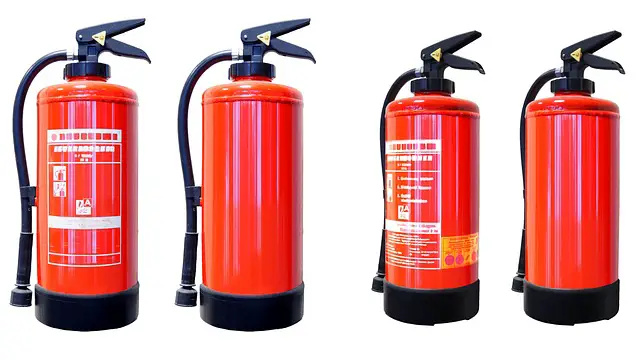Boating is a fun and exhilarating experience, but it also comes with its fair share of risks. One of the most significant risks that boaters face is the risk of fire. To minimize this risk, every boat should have an adequate number of properly maintained and accessible fire extinguishers on board. In this article, we’ll discuss the different types of fires and the requirement for fire extinguishers on a boat.
Types of Fires
Before we dive into the requirements for fire extinguishers on boats, it’s essential to understand the different types of fires that can occur on a boat. There are four main types of fires:
- Class A Fires: Class A fires involve ordinary combustibles such as wood, paper, or cloth. They can usually be extinguished with water, but other types of extinguishing agents may be more effective, depending on the situation.
- Class B Fires: Class B fires involve flammable liquids such as gasoline, oil, or grease. These fires require specialized extinguishing agents such as foam or dry chemical agents to be extinguished.
- Class C Fires: Class C fires involve electrical equipment such as wiring or appliances. These fires can be extinguished with dry chemical agents, carbon dioxide, or other specialized extinguishing agents.
- Class D Fires: Class D fires involve combustible metals such as magnesium, titanium, or sodium. These fires require specialized extinguishing agents such as dry powder agents to be extinguished.
Requirement For Fire Extinguishers On A Boat
The US Coast Guard has established guidelines for the minimum requirements for fire extinguishers on boats. These guidelines are based on the boat’s size, fuel type, and other factors.
- Boats under 26 Feet: Boats under 26 feet in length are required to have at least one B-I type fire extinguisher on board. A B-I fire extinguisher is a portable fire extinguisher that is suitable for use on Class B and Class C fires.
- Boats 26-40 Feet: Boats between 26 and 40 feet in length are required to have at least two B-I or one B-II type fire extinguishers on board. A B-II fire extinguisher is a larger, more powerful fire extinguisher that can be used on Class A, B, and C fires.
- Boats over 40 Feet: Boats over 40 feet in length are required to have at least three B-I or one B-II and one B-I type fire extinguishers on board.
Additional Requirements
In addition to the minimum requirements, boats with enclosed engine compartments must have a fire extinguisher in the compartment, while boats with cooking appliances or heating devices must have a fire extinguisher within 10 feet of the device.
Types of Fire Extinguishers
As mentioned earlier, there are different types of fires, and each requires a specific type of fire extinguisher. The most common types of fire extinguishers are:
- Class A: Class A fire extinguishers are designed to extinguish fires that involve ordinary combustibles such as wood, paper, or cloth.
- Class B: Class B fire extinguishers are designed to extinguish fires that involve flammable liquids such as gasoline, oil, or grease.
- Class C: Class C fire extinguishers are designed to extinguish fires that involve electrical equipment such as wiring or appliances.
- Class D: Class D fire extinguishers are designed to extinguish fires that involve combustible metals such as magnesium, titanium, or sodium.
- Class K: Class K fire extinguishers are designed to extinguish fires that involve cooking oils and fats.
Maintenance and Inspection of Fire Extinguishers
Having the required number of fire extinguishers on board is essential, but it’s also crucial to ensure that they are properly maintained and inspected regularly. A malfunctioning or expired fire extinguisher can be just as dangerous as not having one at all.
Maintenance
Fire extinguishers should be inspected monthly to ensure that they are in good working condition. The inspection should include checking the pressure gauge, verifying that the safety pin is intact, and ensuring that there are no signs of damage or corrosion. Fire extinguishers should also be recharged or replaced if they have been discharged.
Inspection
Boats should have their fire extinguishers inspected at least once a year by a qualified professional. During the inspection, the professional will ensure that the fire extinguisher is still in good working condition and that it meets all current regulations.
Replacement
Fire extinguishers have a limited lifespan, and they must be replaced after a certain number of years, typically between 5 and 15 years depending on the type of extinguisher. It’s crucial to keep track of the expiration dates of your fire extinguishers and replace them promptly when they expire.
Conclusion
In conclusion, the requirement for fire extinguishers on a boat is a crucial safety measure that should not be overlooked. By adhering to the regulations and ensuring that you have the appropriate type and number of fire extinguishers on board, you can greatly reduce the risk of fire-related accidents and protect yourself, your passengers, and your vessel. Remember, safety always comes first, and complying with the requirement for fire extinguishers on a boat is an essential part of that.
Key Takeaways for Requirement For Fire Extinguishers On A Boat
- Boats should have an adequate number of properly maintained and accessible fire extinguishers on board to minimize the risk of fires.
- There are four main types of fires: Class A, Class B, Class C, and Class D. Each requires a specific type of fire extinguisher.
- The US Coast Guard has established guidelines for the minimum requirements for fire extinguishers on boats based on the boat’s size, fuel type, and other factors.
- Fire extinguishers should be inspected monthly, inspected annually by a qualified professional, and replaced after a certain number of years depending on the type of extinguisher.

